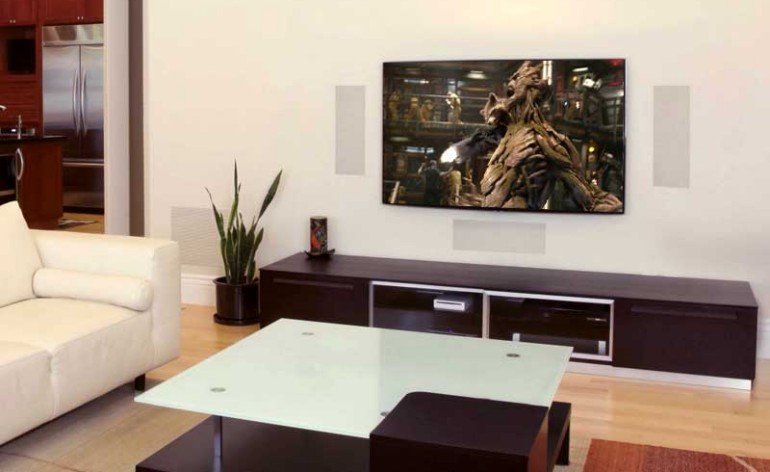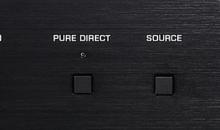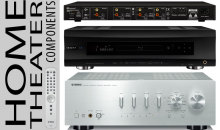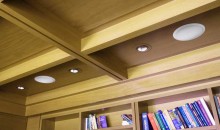Using In-Wall Speakers for Home Theater
I talk about the aesthetics of home theater quite a bit. A lot of times that includes discussions of using soundbars for home theater vs a full 5.1 home theater speaker system. But another way to maintain aesthetics while still getting a great surround experience is by using in-wall speakers for home theater. A pair of in-wall speakers will set right into the drywall and can be nearly invisible if done correctly. Given the time and energy manufacturers have taken to develop these speakers, many of them are light years ahead in sound quality to similarly-priced box speakers. If you haven’t considered using in-wall speakers for home theater surround sound, here are some things to keep in mind and consider:
In-Wall Speakers are Perfect for Front and Center Channels
While I’ve heard of people using side wall-mounted speakers for surround sound, the main function for in-wall speakers is for the front and center channels. In this application, the front and center channels can surround a flat panel television, or even a projector screen, and provide a nice full and wide soundstage for home theater and music. In-wall speakers are also perfect for rooms where there is a lot of wall space available (or at least sufficient wall space) but floor space is at a premium. It allows you to add the sound quality of a full-range pair of speakers into your room without the need to take up a ton of floor space with what would traditionally require a pair of floorstanding towers.
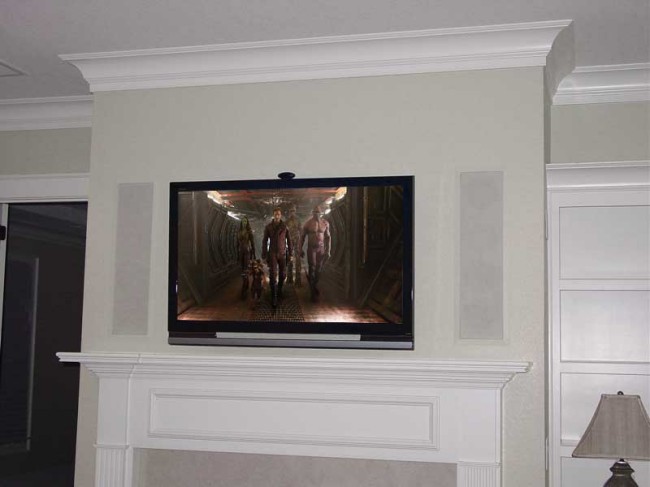
In-wall speakers also do a great job when “ghosting” of the center channel is required. While floorstanding and bookshelf speakers can be toed in to achieve a better soundstage, in-wall speakers are often optimized such that their separation is best set by the calculated distance to the seated area. That means that the width or distance between the speakers is calculated to ensure the stereo image is perfect from the center seat. Since most in-wall speakers have a nice wide horizontal dispersion, multiple center seats are often perfectly optimized for stereo imaging.
Wiring for In-Wall Home Theater Speakers
Obviously, there are trade-offs when you go with an in-wall speaker solution. One of those is the difficulty in wiring. While a pair of towers just need a speaker cable run from your nearby AV receiver, a pair of in-wall speakers need to be cabled up inside your wall. That means you’ll need either attic or crawl space access, or you’ll need to use our hiding the speaker wiring under crown moulding trick. Don’t let the additional work scare you off. One nice thing is that there is sufficient room to work behind a wall where an in-wall speaker will be placed. This lets you quickly snake the cable up or down as needed to make sure you can access the area required to get back to your AV receiver. In many instances, you can just route the cables into the center stud cavity and let them drop down to the bottom where they can be fished out and connected to a wall plate. In this way, you benefit from the larger speaker cutout box you made to house your in-wall speakers.
In-Wall Speakers Have Paintable Grilles
Most in-wall speakers I’ve used have grilles that are paintable. This is great if you like your speakers to be heard and not seen (the opposite of children). A basic pair of in-wall speakers will have a perforated metal grill that is either magnetic or snaps into place. To paint it, you simply remove it or paint it before you snap it into position. While you can accomplish this via spray paint (so that you’re dealing with aerosol particles that do not block up and clog the necessary grille perforations) thinning out your wall paint and carefully using an airbrush will also work. I’ve heard of some people using a paintbrush, but you’ll need to be careful to thin the paint and have a dry brush on hand to follow up and recover any clogged grille perforations.

While some in-wall speakers come with choices of grille colors and fabrics, often the paintable grill is the better choice due to its simplicity and the fact that you don’t just blend the speaker, you match it exactly to your existing painted wall. Note: You should never try to paint fabric, only rigid perforated materials.
Specialty In-Wall Speakers Can be Hit or Miss
While we advocate the use of in-wall speakers, some models go a bit too far in trying to match the aesthetics of a room. Some of these speakers exist behind the drywall and produce a more muffled, compensated sound that seems to emanate from no specific point. It’s a neat effect (almost like magic) but the stereo imaging and fidelity isn’t the best. These systems must also be installed perfectly, or there will eventually be hairline cracks around the perimeter of the speaker frame.
Whether you’re going for total aesthetics, or you just need the extra floor space, using in-wall speakers for home theater is a great way to design and build a beautiful home theater that can produce a top-notch sound for your family and friends to enjoy.

